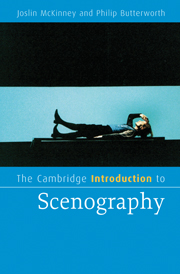Book contents
- Frontmatter
- Contents
- List of illustrations
- List of boxed quotations
- Preface
- Acknowledgements
- Part 1 Elements
- Part 2 Processes of scenography
- Chapter 3 Text as conditioner of image
- Chapter 4 Recognising and realising space
- Chapter 5 Technology as performance
- Part 3 Realisation and reception
- Notes
- Bibliography
- Index
- Cambridge Introductions to …
Chapter 4 - Recognising and realising space
Published online by Cambridge University Press: 05 February 2015
- Frontmatter
- Contents
- List of illustrations
- List of boxed quotations
- Preface
- Acknowledgements
- Part 1 Elements
- Part 2 Processes of scenography
- Chapter 3 Text as conditioner of image
- Chapter 4 Recognising and realising space
- Chapter 5 Technology as performance
- Part 3 Realisation and reception
- Notes
- Bibliography
- Index
- Cambridge Introductions to …
Summary
Configuration and manipulation of space in relation to the performance event is the key element in determining the nature of scenography. Why is this? In the first instance, it is because of what happens within the confines of the theatre stage. The special characteristic of the stage space is that anything that happens in it is offered for the attention, reception and consideration of the audience and is presumed to have some kind of intended effect or meaning. Take, for example, the placement of a chair on stage. This chair ‘is first and foremost onstage, and before it conveys any information about the fictional world or the real world outside the theatre it presents itself to the spectators as a theatrical chair’. The framing nature of stage space and its contained objects suggests and stimulates expectations of the action that is about to take place. Those particular qualities of a given stage space, as defined through the setting, objects within the setting, lighting, costumes and sound, also have a tangible and concrete influence upon the performed action.
The way space is determined and organised brings about different possibilities with regard to the functions of space in performance. Attempts have been made to clarify spatial function in the theatre in ways that distinguish between ‘stage space’, ‘presentational space’ and ‘fictional space’.
- Type
- Chapter
- Information
- The Cambridge Introduction to Scenography , pp. 104 - 125Publisher: Cambridge University PressPrint publication year: 2009



